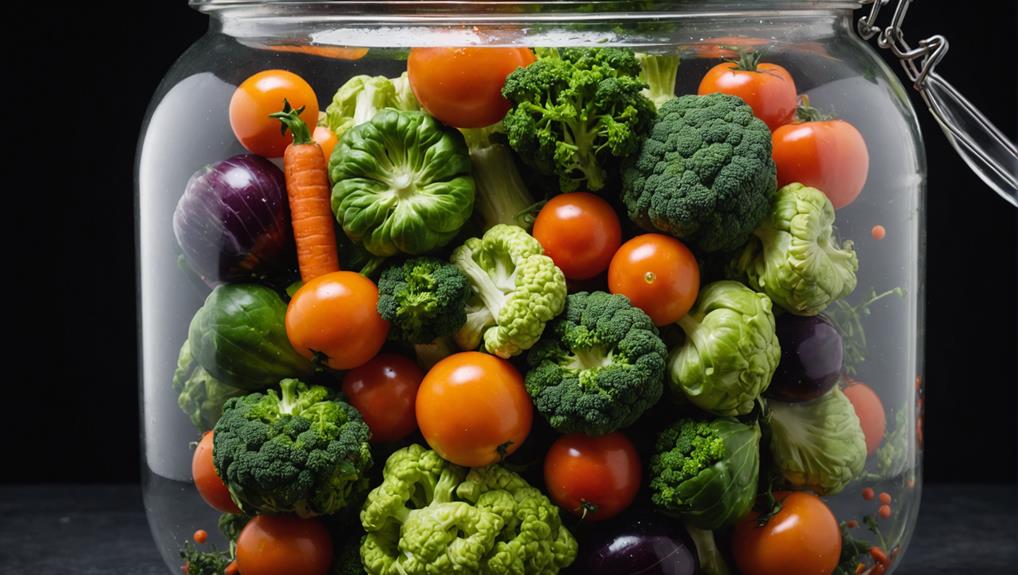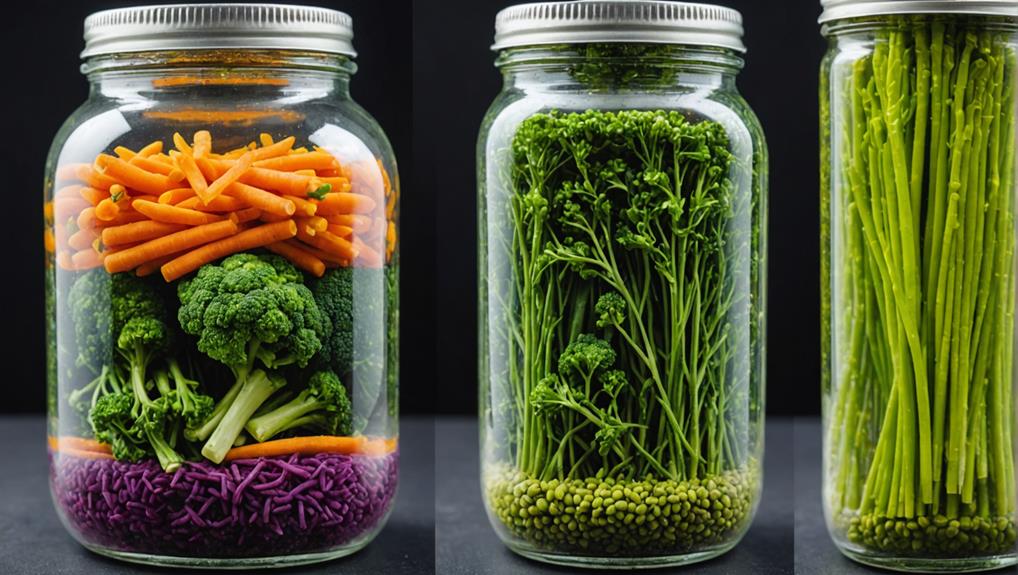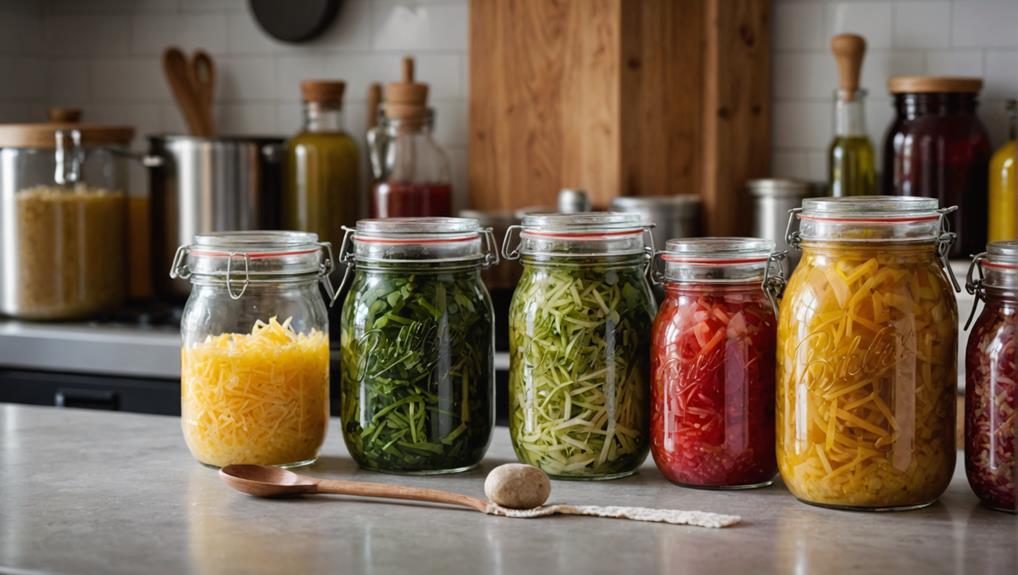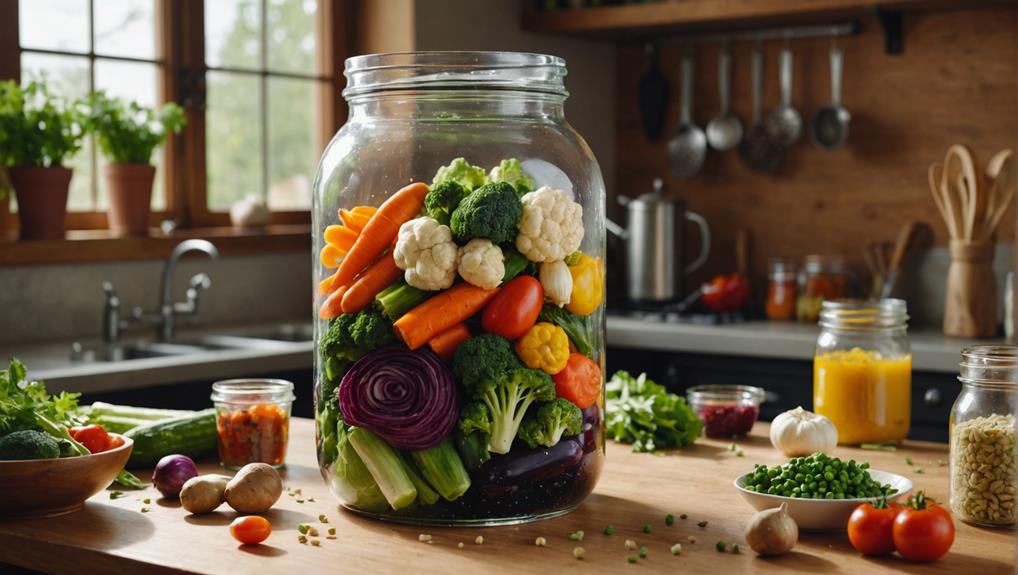Fermentation is a microbial process that transforms sugars into acids, gases, or alcohol, enhancing flavors and preserving foods. You'll encounter two main types: alcoholic and lactic acid fermentation. Key players include lactic acid bacteria, yeasts, and molds, each contributing unique qualities to your ferments. To succeed, create an anaerobic environment using airtight containers and maintain optimal pH and temperature levels. Enzymes play a crucial role, catalyzing specific reactions during fermentation. The lactic acid formation process involves complex biochemical pathways, resulting in probiotic-rich foods with numerous health benefits. By mastering cleanliness, ingredient selection, and fermentation duration, you can create delicious, nutritious ferments at home. Explore further to unlock the full potential of this microbial magic.
The Science of Fermentation
Delving into the science of fermentation, you'll find a fascinating metabolic process that's been harnessed by humans for millennia. At its core, fermentation is a microbial transformation that converts sugars into acids, gases, or alcohol.
You're dealing with two main types: alcoholic and lactic acid fermentation. The former is crucial for crafting your favorite New York craft beers, while the latter gives you tangy yogurt and crisp pickles.
As you explore fermentation, you'll discover its power to preserve and enhance food. Lactic acid bacteria, nature's tiny preservatives, lower pH levels and keep harmful microbes at bay. This not only extends shelf life but also boosts food safety.
You're also tapping into a world of enzymes like amylases and proteases, which break down complex molecules, making nutrients more accessible to your body.
The real magic happens in your gut. Fermented foods are probiotic powerhouses, supporting your microbiome and immune system.
Key Microbial Players
In your journey to master fermentation, you'll encounter three key microbial players that shape the process and flavors of fermented foods.
First, bacteria like Lactobacillus and Streptococcus convert sugars to lactic acid, creating tangy flavors in dairy and vegetable ferments.
Next, you'll find yeasts, particularly Saccharomyces cerevisiae, which are essential for alcoholic fermentation in beer and bread production.
Bacteria: Lactic Acid Producers
Lactic acid bacteria (LAB) take center stage in the world of fermentation. These gram-positive microorganisms are the powerhouses behind many of your favorite fermented foods.
As you delve into LAB characteristics, you'll discover their remarkable ability to thrive in oxygen-free environments, outcompeting harmful bacteria and ensuring food safety. This unique trait makes them invaluable in fermentation applications, from yogurt to sauerkraut.
You'll find that LAB's metabolic prowess extends beyond lactic acid production. They're also excellent probiotic sources, generating beneficial compounds like vitamins B and K. By harnessing these microbes, you're not just preserving food; you're enhancing its nutritional value.
When you're working with LAB, remember that genera like Lactobacillus, Streptococcus, and Leuconostoc each bring distinct flavors and textures to your ferments.
As they lower the pH of your food, they're creating an inhospitable environment for pathogens, naturally extending shelf life. By understanding and manipulating these microbial workhorses, you'll unlock new possibilities in fermentation, pushing the boundaries of flavor, nutrition, and food preservation.
Yeasts: Alcohol Fermentation Specialists
From the microscopic world of fermentation emerges another key player: yeasts. These single-celled fungi are the alcohol fermentation specialists you'll want to master for crafting exceptional beverages. At the heart of their power lies Saccharomyces cerevisiae, a species that transforms sugars into ethanol and carbon dioxide under anaerobic conditions.
Understanding yeast metabolism is crucial for your fermentation success. For every glucose molecule consumed, yeasts produce about two ethanol and two carbon dioxide molecules.
You'll want to keep fermentation temperature between 20°C to 30°C (68°F to 86°F) for optimal results. Too hot, and you'll stress the yeast, leading to unwanted byproducts; too cold, and you'll slow down the process.
But yeasts aren't just alcohol factories; they're flavor architects. Different strains can impart unique flavor profiles to your creations, from fruity and floral to spicy notes.
This versatility extends beyond alcoholic beverages, as yeasts play vital roles in bread-making and certain dairy productions. By mastering yeast fermentation, you'll unlock a world of innovative culinary possibilities.
Molds: Flavor-Enhancing Fungi
Stepping beyond yeasts, we encounter another fascinating group of microorganisms in the fermentation world: molds. These flavor-enhancing fungi play a crucial role in transforming ordinary ingredients into extraordinary culinary delights.
As you delve into the realm of mold varieties, you'll discover their remarkable ability to break down complex compounds and enhance flavor profiles in various fermented products.
When exploring fermentation techniques, you'll find that molds like *Penicillium camemberti* are responsible for the distinctive white rind and earthy flavors of Camembert and Brie cheeses.
In tempeh production, *Rhizopus oligosporus* transforms soybeans into a protein-rich food with a unique nutty taste.
You'll also encounter *Aspergillus oryzae*, a key player in sake fermentation, converting starches into sugars for alcohol production.
Creating an Anaerobic Environment

The success of fermentation hinges on creating an anaerobic environment. To unlock the full potential of your fermented creations, you'll need to master the art of eliminating oxygen from your fermentation vessels. By establishing anaerobic conditions, you're not just preventing spoilage; you're cultivating a microbial playground where beneficial bacteria can thrive and transform your ingredients.
Start by selecting the right equipment. Airtight containers, fermentation crocks, or vacuum-sealed bags are your allies in limiting oxygen exposure. These vessels create a barrier against unwanted aerobic microorganisms, ensuring your ferments develop complex flavors without interference.
Next, focus on maintaining the ideal pH and temperature. Aim for a pH below 4.6 to inhibit harmful pathogens and keep your ferments safe. Monitor the temperature, keeping it between 60°F and 75°F for optimal results.
Don't forget the power of salt in creating anaerobic conditions, especially for vegetables like cabbage. It draws out moisture and encourages lactic acid bacteria growth, further protecting your ferments.
Enzymatic Reactions in Fermentation
Enzymes are the unsung heroes of fermentation, orchestrating a complex dance of chemical reactions that transform your ingredients.
These microscopic catalysts work tirelessly to break down sugars into alcohol, acids, and gases, all while operating in an oxygen-free environment.
To harness the power of enzymatic reactions in your fermentation projects, you'll need to understand the key players and their optimal conditions.
Consider these crucial aspects of enzyme activity in fermentation:
- Enzyme specificity: Different enzymes catalyze specific reactions, such as zymase converting glucose to ethanol.
- Temperature optimization: Most fermentative enzymes work best between 30-37°C, so maintain this range for peak efficiency.
- pH control: Keep pH levels around 4.5 for lactic acid bacteria to thrive and produce desired flavors.
Lactic Acid Formation Process

When you're exploring lactic acid formation, you'll encounter a fascinating biochemical pathway involving glucose conversion to pyruvate, followed by its reduction to lactic acid.
This process is driven by the enzyme lactate dehydrogenase, which becomes especially active in low-oxygen conditions.
You'll find that various microbial species, particularly lactic acid bacteria like Lactobacillus and Streptococcus, play a crucial role in this fermentation process, producing lactic acid as a byproduct while lowering the pH of their environment.
Biochemical Pathway Breakdown
Understanding the biochemical pathway of lactic acid formation is crucial for mastering fermentation. You'll dive into the intricate enzymatic pathways that drive this process, exploring the metabolic adaptations that occur during anaerobic conditions. By grasping these concepts, you'll unlock the key to improving fermentation efficiency in various applications.
The biochemical pathway of lactic acid formation unfolds in two main stages:
- Glycolysis: Glucose is broken down into two pyruvate molecules, generating two ATP.
- Pyruvate reduction: Lactate dehydrogenase converts pyruvate to lactic acid, replenishing NAD+.
- NADH utilization: This step ensures the continuation of glycolysis by maintaining NAD+ levels.
You'll find that this process isn't just limited to muscle cells during intense exercise. It's a fundamental mechanism in food production, where lactic acid bacteria play a vital role in fermenting dairy products and preserving foods.
Microbial Species Involved
Dive into the world of microbial species responsible for lactic acid formation, and you'll find a diverse group of bacteria at work. At the forefront are lactic acid bacteria (LAB), including Lactobacillus, Streptococcus, and Leuconostoc. These tiny powerhouses excel at converting sugars into lactic acid under oxygen-free conditions.
You'll find Lactobacillus species particularly adept at fermenting lactose, the sugar in milk, which is why they're crucial in yogurt production.
As you explore bacterial diversity in fermentation, you'll discover that LAB don't just produce lactic acid. They're also responsible for creating other metabolic byproducts like carbon dioxide and ethanol, which contribute to the unique flavors and textures of fermented foods.
To optimize your fermentation process, you'll want to maintain the ideal fermentation temperature between 30°C and 40°C (86°F to 104°F). This range allows LAB to thrive and efficiently carry out their fermentation magic.
Health Benefits of Probiotics
Probiotics have emerged as powerful allies in our quest for better health. These beneficial microorganisms offer a range of advantages when consumed regularly, from improving digestive health to enhancing immune function.
You'll find probiotic sources in fermented foods like yogurt, kefir, sauerkraut, and kimchi, which not only provide beneficial bacteria but also contribute essential nutrients to your diet.
The impact of probiotics on gut microbiota is significant, particularly in addressing digestive issues. They've shown effectiveness in:
- Alleviating symptoms of irritable bowel syndrome (IBS)
- Preventing antibiotic-associated diarrhea
- Reducing abdominal pain and bloating
Beyond digestive health, probiotics are revolutionizing our approach to mental health.
Research suggests a connection between gut bacteria and brain function through the gut-brain axis. Some studies indicate that regular probiotic consumption may help reduce symptoms of anxiety and depression, opening new avenues for mental health support.
Mastering Fermentation at Home

Ready to embark on your home fermentation journey? Understanding the basics of fermentation is crucial as you dive into this microbial magic. Start by creating a clean environment and sterilizing your fermentation tools to prevent unwanted contamination. The success of your ferments depends on maintaining a delicate balance of beneficial microorganisms.
Ingredient selection is key to your fermentation adventures. Experiment with various vegetables, fruits, and grains to discover unique flavors and textures. Don't be afraid to try different fermentation times to achieve your desired results. Remember, fermentation is a dynamic process that evolves over time.
Temperature control plays a vital role in successful fermentation. Most vegetable ferments thrive at around 68-72°F, so keep this in mind when choosing your fermentation location.
As you explore flavor experimentation, keep detailed notes on your ingredient ratios, fermentation duration, and environmental conditions. This will help you refine your techniques and reproduce your favorite ferments consistently.
Frequently Asked Questions
Can Fermented Foods Expire or Spoil?
Yes, fermented foods can expire. You'll want to watch for signs of spoilage like mold or off-odors. Proper storage conditions are crucial for maximizing fermentation longevity. Embrace innovation by experimenting with different preservation techniques to extend shelf life.
How Do Different Salt Levels Affect Fermentation Outcomes?
You'll find that salt concentration affects fermentation outcomes dramatically. Higher levels slow the process, while lower levels speed it up. Optimal salt ratios influence flavor development, so experiment to discover your preferred balance of taste and preservation.
Are There Risks Associated With Consuming Too Many Fermented Foods?
You're innovating your diet, but beware: probiotic overconsumption can backfire. Too many fermented foods might cause digestive distress, impacting nutrient absorption. Balance is key. Experiment wisely to reap the benefits without overwhelming your system.
Can Fermentation Occur at High Altitudes or Extreme Temperatures?
Like a resilient explorer, fermentation can adapt to various environments. You'll find high altitude fermentation and extreme temperatures affect microbial activity. However, innovative techniques allow you to control these factors, ensuring successful fermentation even in challenging conditions.
Is It Possible to Revive a Failed Fermentation Project?
You can often revive a failed fermentation. Troubleshoot by checking temperature, pH, and contamination. Common mistakes include incorrect ratios or poor starter quality. Look for signs of revival like bubbling or renewed activity. Don't give up—innovation often requires persistence!
Final Thoughts
You've now unlocked the secrets of fermentation, a microbial dance that transforms ordinary ingredients into culinary treasures. Armed with knowledge of the key players, ideal environments, and enzymatic processes, you're ready to embark on your own fermentation journey. Remember, patience is your ally as you cultivate beneficial bacteria and yeasts. With practice, you'll soon be crafting delicious, probiotic-rich foods that nourish your body and delight your taste buds. The world of fermentation awaits your exploration.













